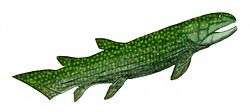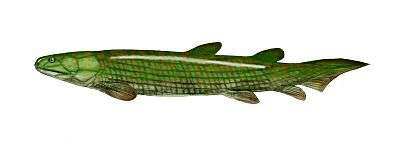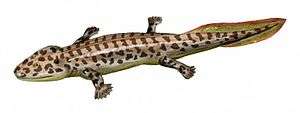Hynerpeton
| Hynerpeton | |
|---|---|
 | |
| Hynerpeton reconstruction | |
| Scientific classification | |
| Kingdom: | Animalia |
| Phylum: | Chordata |
| Order: | "Ichthyostegalia" |
| Family: | Ichthyostegidae |
| Genus: | †Hynerpeton |
| Species: | †H. bassetti |
| Binomial name | |
| Hynerpeton bassetti Daeschler et al., 1994 | |
Hynerpeton (/haɪˈnɜːrpətɒn/; from Hyner and Ancient Greek ἑρπετόν (herpetón), "creeping animal," meaning "creeping animal from Hyner") was a basal carnivorous tetrapod that lived in the lakes and estuaries of the Late Devonian period around 360 million years ago. Like many primitive tetrapods, it is sometimes referred to as an "amphibian" in reference to its reproduction, though it is not a member of the modern Lissamphibia.
The structure of the shoulder girdle indicates this animal may have been one of the earlier, more primitive tetrapods to evolve during the Devonian. Hynerpeton has extremely powerful muscles in it arms, neck, and around its chest, which allowed to support its full weight on land, one of the first of its kind to do so.
History
In 1993, the paleontologists Ted Daeschler and Neil Shubin found the first Hynerpeton fossil, a shoulder bone, near Hyner, Pennsylvania, USA. They were surveying the Devonian rocks of Pennsylvania in search of fossil evidence for the origin of animal limbs. The initial find was a very robust shoulder bone, which indicated that the animal had powerful appendages.[1] Only a few Hynerpeton bones have been found there at Red Hill, Pennsylvania. These include two shoulder girdles, two lower jaws, a jugal bone and some gastralia.
Evolution
It is thought that these early amphibians are descended from lobe-finned fish, such as Hyneria, whose stout fins evolved into legs and their swim bladder into lungs. It is still unknown whether Hynerpeton is the ancestor to all later backboned land animals (including humans and many land creatures), but the fact that it had eight fingers (on each of its "hands"), not five, "...suggests that it is simply our evolutionary cousin"(Haines 31).
The Late Devonian period saw the evolution of plants into trees and growing into vast forests pumping oxygen into the air, creating levels of oxygen much higher than today. This gave Hynerpeton an edge because it evolved complex lungs to exploit it. Its lungs probably consisted of sacs like modern terrestrial vertebrates. Hynerpeton breathed in and out with its lungs.
See also
References
- ↑ Shubin, Neil (2009). Your Inner Fish: A Journey Into the 3.5-Billion-Year History of the Human Body. New York: Vintage. p. 13. ISBN 978-0-307-27745-9.
External links






